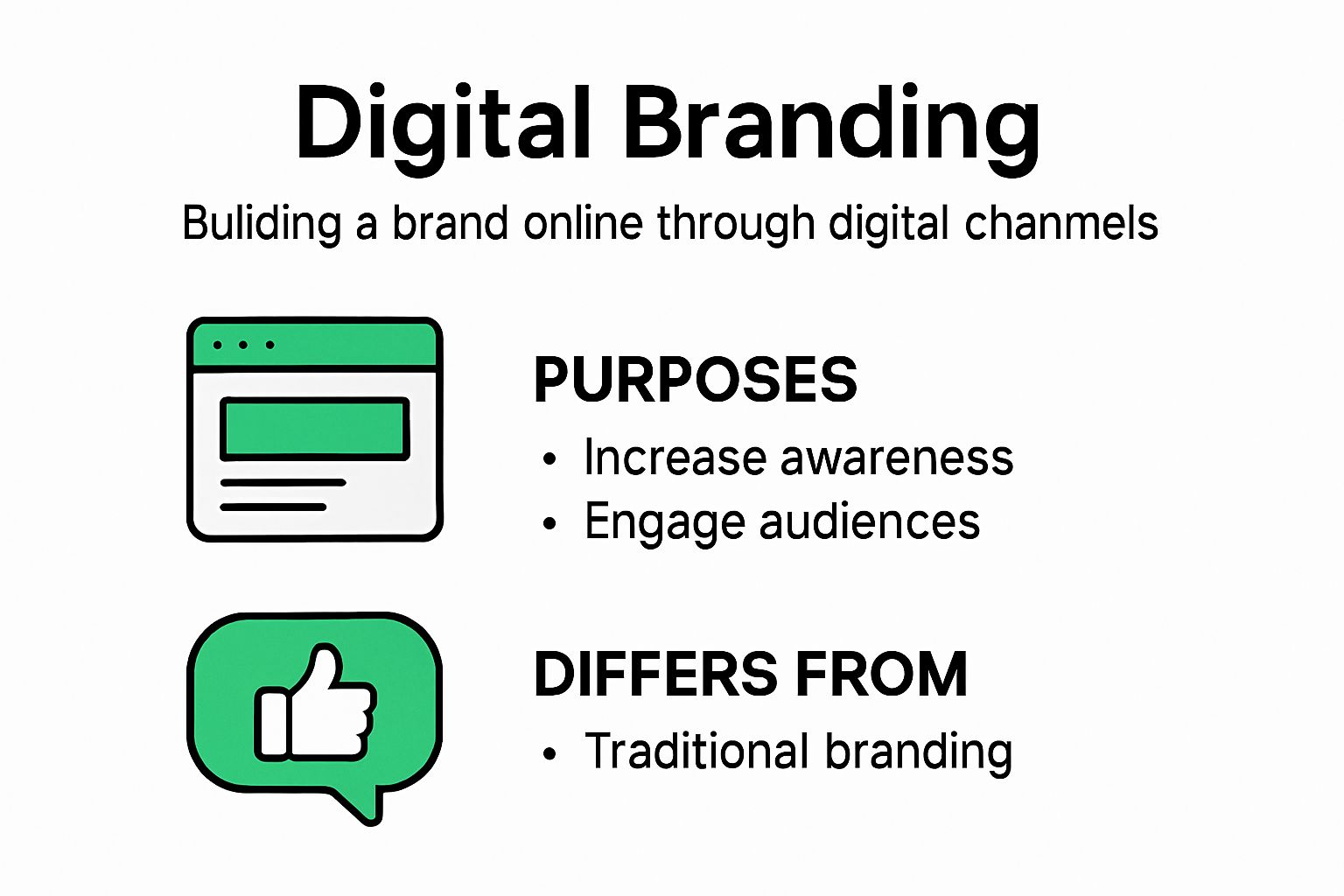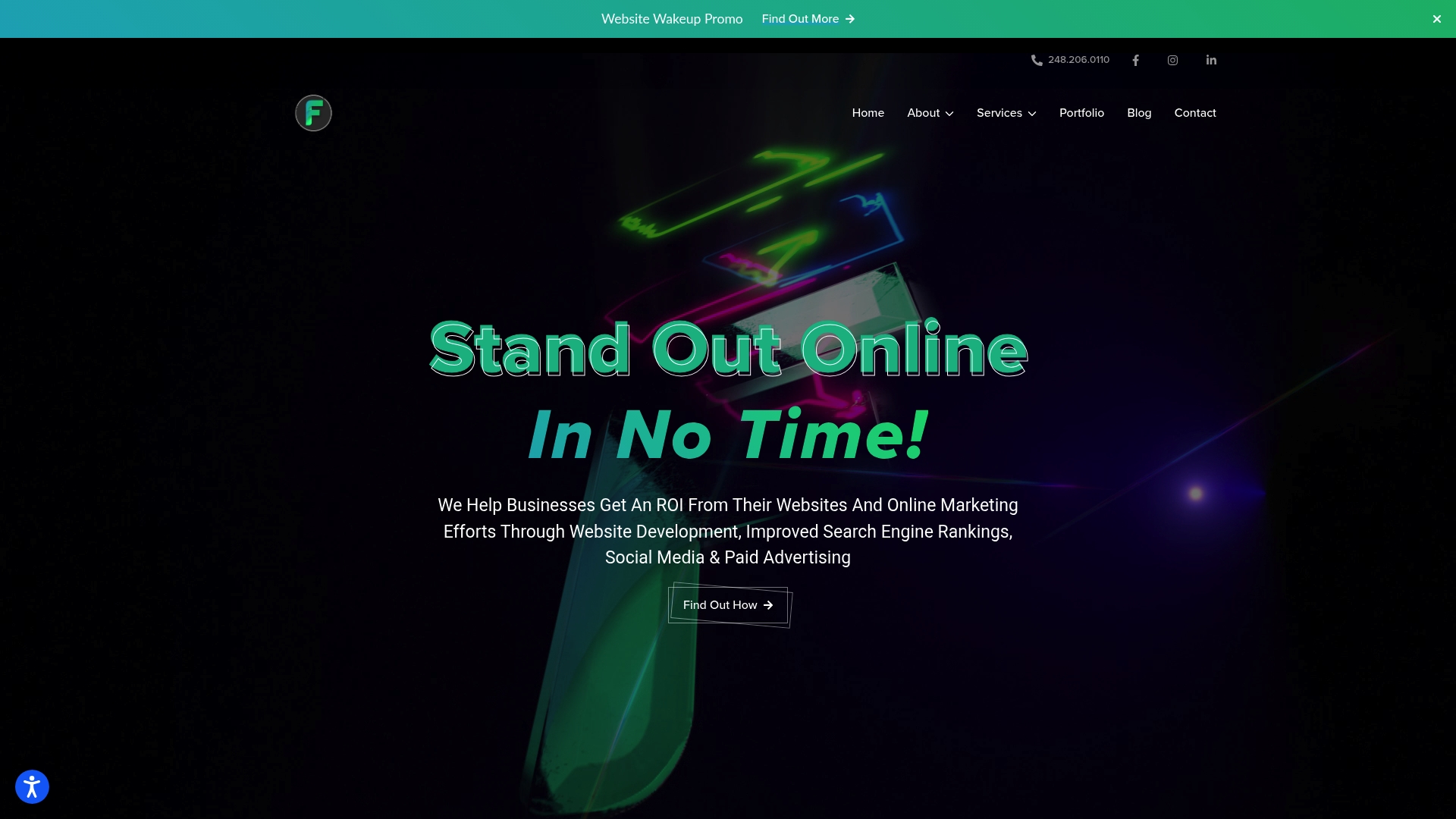What Is Digital Branding? Small Business Guide 2025

Digital branding is shaping the way small businesses get noticed online. Research shows digital branding can increase brand exposure for small businesses more effectively than traditional marketing channels. Sounds like a win for everyone, right? Not quite. Most small businesses overlook the single biggest reason digital branding actually works—connecting with the right people at exactly the right moment.
Table of Contents
- Understanding What Is Digital Branding
- Key Elements Of A Strong Digital Brand
- Steps To Build Your Digital Brand
- Benefits Of Digital Branding For Small Businesses
Quick Summary
| Takeaway | Explanation |
|---|---|
| Establish a Unique Online Identity | Digital branding involves creating a cohesive online presence that reflects a business’s core values and connects meaningfully with its audience across various digital platforms. |
| Consistency is Key | Maintaining visual and messaging consistency across all digital channels is crucial for brand recognition and customer trust, ensuring every element reinforces the brand’s identity. |
| Understand Your Audience | Conduct thorough market research to define and target your ideal audience. This insight enables tailored content and strategies that resonate with their needs and preferences. |
| Leverage Cost-Effective Marketing | Digital branding provides affordable opportunities for small businesses to reach larger audiences, particularly through social media, content marketing, and targeted advertising. |
| Embrace Data-Driven Strategies | Utilize analytics to track performance and audience engagement. This data helps refine digital branding efforts for more effective and responsive marketing tactics. |
Understanding What Is Digital Branding
Digital branding represents a strategic approach for businesses to establish a powerful online presence and connect meaningfully with their target audience. Digital branding goes beyond traditional marketing by creating a comprehensive and cohesive digital identity that resonates across multiple online platforms.

The Core Definition of Digital Branding
At its essence, digital branding is the process of crafting a unique online identity that communicates a company’s core values, personality, and promise. According to research from OSF, digital branding involves using digital tools and channels to develop a consistent brand message that engages potential customers. Unlike traditional branding, which relied primarily on physical touchpoints, digital branding leverages websites, social media, email, and other digital platforms to create immersive brand experiences.
The fundamental goal is not just about driving immediate sales but about building long-term brand recognition and emotional connections. Wikipedia’s digital branding overview highlights that successful digital branding aims to establish brand awareness, develop a distinctive image, and cultivate customer loyalty through strategic online interactions.
Key Components of Effective Digital Branding
Successful digital branding requires a multifaceted approach that integrates several critical elements. Visual consistency plays a crucial role, ensuring that logos, color schemes, typography, and imagery remain uniform across all digital channels. This visual cohesiveness helps customers instantly recognize and remember your brand.
Content strategy is another vital component. Your digital brand should communicate a clear, compelling narrative that differentiates you from competitors. This means developing content that not only showcases your products or services but also reflects your brand’s unique personality and values. Whether through blog posts, social media updates, or video content, every piece of digital communication should reinforce your brand’s core message.
Technology and user experience are equally important. A responsive website, intuitive navigation, fast loading times, and mobile optimization are no longer optional but essential for creating a positive digital brand impression. Customers expect seamless, engaging digital experiences that reflect a brand’s commitment to quality and innovation.
Moreover, digital branding requires ongoing engagement and adaptability. The online world evolves rapidly, and brands must be prepared to adjust their strategies, listen to customer feedback, and leverage emerging digital platforms to stay relevant. This dynamic approach ensures that your digital brand remains fresh, authentic, and connected to your target audience’s changing needs and preferences.
Key Elements of a Strong Digital Brand
Building a robust digital brand requires strategic planning and a holistic approach that goes beyond superficial design elements. Digital brand strength emerges from carefully integrated components that work together to create a memorable and authentic online presence.
Visual Identity and Consistency
Visual identity serves as the fundamental foundation of digital branding. According to research from Georgia Digital, maintaining a consistent visual representation across all digital platforms is crucial for brand recognition and trust. This means developing a comprehensive visual system that includes:
- Logo Design: A versatile logo that translates effectively across different digital mediums
- Color Palette: A strategic selection of colors that evoke specific emotions and align with brand personality
- Typography: Consistent font choices that enhance readability and reinforce brand character
The goal is to create a visual language that customers can instantly recognize, regardless of where they encounter your brand online. Every visual element should tell a cohesive story about your brand’s identity and values.
To help you quickly review the visual brand identity features discussed, here’s a summary table of the main elements and their importance:
| Visual Identity Element | Description | Purpose |
|---|---|---|
| Logo Design | Versatile logo adapted for all digital media | Establishes brand recognition |
| Color Palette | Strategic colors reflecting brand personality | Evokes emotion, aligns with values |
| Typography | Consistent, readable font choices | Enhances readability, reinforces character |
Brand Voice and Messaging Strategy
Research from Uplarn emphasizes that a consistent brand voice is fundamental to building trust and recognition. Your digital brand’s voice should reflect your company’s personality, whether it’s professional, playful, authoritative, or conversational. This means developing communication guidelines that ensure every piece of content sounds like it comes from the same source.
Effective brand messaging goes beyond mere communication. It involves:
- Crafting a clear, compelling brand narrative
- Developing messaging that resonates with your target audience
- Creating content that provides genuine value
- Maintaining a consistent tone across all digital channels
User Experience and Digital Presence
Build with Bolt’s research highlights that user experience is a critical element of digital branding. A well-designed digital presence goes far beyond aesthetics, focusing on creating seamless, intuitive interactions that reflect your brand’s commitment to customer satisfaction.
Key considerations for exceptional digital user experience include:
- Responsive website design that works flawlessly across devices
- Intuitive navigation that helps users find information quickly
- Fast loading times and smooth performance
- Accessible design that accommodates diverse user needs
Moreover, your digital presence should extend beyond your website. Social media platforms, email communications, and other digital touchpoints should all reflect the same level of thoughtfulness and brand consistency. Each interaction is an opportunity to reinforce your brand’s values and build deeper connections with your audience.
Building a strong digital brand is an ongoing process of refinement, listening, and adapting. By focusing on visual consistency, authentic messaging, and exceptional user experience, businesses can create a digital brand that not only attracts attention but also builds lasting customer relationships.
Steps to Build Your Digital Brand
Building a compelling digital brand requires a systematic approach that transforms your online presence from generic to memorable. Digital brand development is a strategic journey that demands careful planning, consistent execution, and continuous refinement.

Defining Your Brand Vision and Core Identity
Research from Craft and Code Agency emphasizes that establishing a clear brand vision serves as the foundational blueprint for your digital strategy. This process involves deep introspection about what makes your business unique.
Start by articulating your core values, mission statement, and unique selling proposition. Ask yourself critical questions: What problem does your business solve? What principles guide your work? How do you want customers to feel when they interact with your brand?
Your brand identity should transcend mere visual elements. It encompasses your business philosophy, the promises you make to customers, and the experiences you consistently deliver. This means developing a comprehensive narrative that explains not just what you do, but why you do it.
Understanding and Targeting Your Audience
Harvard Business School Online recommends conducting thorough market research to precisely identify and understand your target audience. This step goes beyond basic demographic information, requiring a nuanced understanding of customer behaviors, preferences, pain points, and digital consumption habits.
Effective audience targeting involves:
- Demographic Analysis: Age, location, income level, education
- Psychographic Segmentation: Values, interests, lifestyle choices
- Digital Behavior Mapping: Online platform preferences, content consumption patterns
Develop detailed customer personas that represent your ideal clients. These personas will guide your content creation, messaging strategy, and digital engagement approaches. The more accurately you can speak directly to your audience’s needs and aspirations, the more compelling your digital brand becomes.
The following table organizes the main steps for building your digital brand for easy reference:
| Step | Description | Key Actions |
|---|---|---|
| 1. Define Brand Vision & Identity | Clarify core values, mission, and unique selling proposition | Articulate philosophy, promises, and experiences |
| 2. Understand & Target Audience | Research demographics, psychographics, and behavior | Build detailed personas, guide content and messaging |
| 3. Develop Digital Marketing Plan | Set strategy across channels, KPIs, and tactics | Outline content, social, SEO, ads, email, analytics |
Developing a Strategic Digital Marketing Plan
EDX’s Digital Marketing Insights suggests creating a comprehensive digital marketing plan that serves as a roadmap for your brand’s online growth. This strategic document should outline clear goals, specific tactics, and measurable key performance indicators (KPIs).
Your digital marketing plan should address:
- Content strategy across different platforms
- Social media engagement approach
- Search engine optimization tactics
- Paid digital advertising strategies
- Email marketing frameworks
- Performance tracking and analytics
Remember that a digital marketing plan is not a static document but a dynamic strategy that requires regular review and adaptation. The digital landscape evolves rapidly, and your brand must remain agile and responsive to emerging trends, technological changes, and shifting customer expectations.
Building a digital brand is an ongoing process of learning, experimenting, and refining. By approaching it systematically with clear vision, deep audience understanding, and a flexible strategic plan, you can create a digital brand that not only attracts attention but builds genuine, lasting connections with your target audience.
Benefits of Digital Branding for Small Businesses
Digital branding offers small businesses unprecedented opportunities to compete, grow, and connect with customers in ways that were previously impossible. Digital branding levels the playing field, enabling small enterprises to punch well above their weight in a crowded marketplace.
Enhanced Brand Visibility and Recognition
Research from ResearchGate reveals that digital platforms dramatically increase brand exposure for small businesses. Unlike traditional marketing channels that require significant financial investment, digital branding provides cost-effective methods to reach wider audiences.
Small businesses can leverage various digital channels to build brand recognition:
- Social Media Platforms: Create engaging content that showcases brand personality
- Content Marketing: Develop valuable blog posts and resources that demonstrate expertise
- Search Engine Optimization: Improve online visibility and attract potential customers
These strategies allow small businesses to create a memorable digital presence that competes with larger, more established brands. By consistently sharing authentic and valuable content, businesses can build trust and credibility with their target audience.
Cost-Effective Marketing and Growth
ResearchGate’s study highlights the significant cost advantages of digital branding. Traditional advertising methods often require substantial financial investments that small businesses cannot afford. Digital branding offers a more accessible and affordable alternative.
Key cost-effective benefits include:
- Low-Cost Marketing Channels: Social media, email marketing, and content creation require minimal financial investment
- Targeted Advertising: Precise audience targeting reduces wasted marketing spend
- Scalable Marketing Strategies: Businesses can start small and expand as they grow
This approach allows small businesses to implement sophisticated marketing strategies without breaking the bank, enabling more efficient resource allocation and potential growth.
Data-Driven Strategy and Continuous Improvement
Research findings emphasize the power of data-driven decision making in digital branding. Unlike traditional marketing methods, digital platforms provide real-time analytics and insights that help businesses understand and optimize their strategies.
Small businesses can benefit from:
- Performance Tracking: Measure engagement, conversion rates, and customer interactions
- Audience Insights: Understand customer behavior and preferences
- Rapid Strategy Adaptation: Quickly modify marketing approaches based on data
These analytical capabilities enable small businesses to continuously refine their digital branding efforts, ensuring more effective communication and better alignment with customer needs.
Digital branding is no longer a luxury but a necessity for small businesses. By embracing digital strategies, companies can create powerful online identities, reach broader audiences, and compete effectively in an increasingly digital marketplace. The key is to approach digital branding as an ongoing journey of learning, engagement, and strategic adaptation.
Frequently Asked Questions
What is digital branding?
Digital branding is the process of creating a unique online identity that reflects a business’s core values and connects meaningfully with its target audience across various digital platforms.
Why is digital branding important for small businesses?
Digital branding enhances brand visibility, builds customer trust, and provides cost-effective marketing opportunities that help small businesses compete with larger companies in the digital marketplace.
What are the key components of effective digital branding?
Key components include visual consistency across digital channels, a compelling brand voice and messaging strategy, and a strong focus on user experience and digital presence.
How can small businesses build their digital brand?
Small businesses can build their digital brand by defining their brand vision, understanding and targeting their audience, and developing a strategic digital marketing plan that aligns with their goals.
Ready to Finally Stand Out With Digital Branding That Works?
Struggling to transform your online presence into real customer connections? As highlighted in the article, most small businesses miss out on digital branding success because they fail to reach the right people at the right time. If you want visual consistency, a unified voice, and ROI-driven strategies, but you are not sure where to begin, you are not alone. The gap between simply being online and actually being seen, remembered, and chosen can feel overwhelming. Your brand deserves more than generic marketing tactics.

It is time to move past inconsistency and wasted marketing spend. Discover how Finepoint Design can help you build a targeted, data-driven digital brand that delivers results. We turn your website, search rankings, and online campaigns into real business growth. Visit our website now to see how we help businesses like yours thrive online with proven digital branding solutions. Do not wait—start turning clicks into loyal customers today.